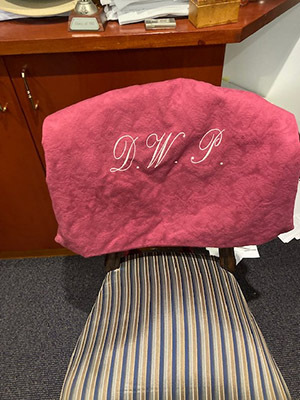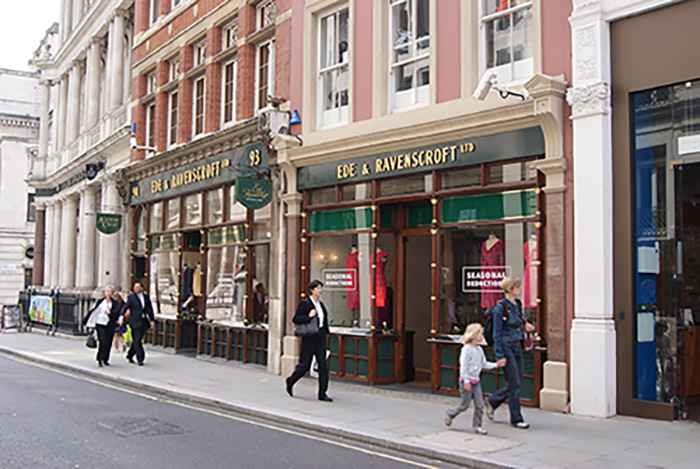- Winter 2022
- History of the barrister's red bag

In 2014, I was presented with a red brief bag by Bruce Houlder QC, while practising in England. Bruce had led me in a trial involving the prosecution of a soldier who had mistreated a captured insurgent in Afghanistan. The case was appealed to the Court of Appeal Criminal Division at the Royal Courts of Justice in the Strand. This article briefly outlines the origin of silks presenting red bags to juniors at the bar.
Justice Sackar QC, when being sworn into the Supreme Court of NSW in 2011, noted that the tradition of silk presenting red brief bags to junior counsel was not as widespread as it once was. In his address Justice Sackar referred to the occasion when he was presented with his red bag, as a junior, by Doug Staff QC. He said:
I was rather overcome with the gesture until I realised that the tradition also involved having the initials of one’s leader, not mine embroidered on the side. Clearly an early form of product placement it was nonetheless an important vote of confidence which I have cherished the whole of my professional life.
The practice of silks giving red bags to promising juniors, whom they have led in a case, continues to be observed in several common law jurisdictions including Canada, Australia, England and Wales, and parts of the former British West Indies. The red bag is normally presented with a note of thanks by the giving silk. Indeed, red bags purchased from Ede and Ravenscroft1,2 come with a piece of parchment fixed inside for this purpose.

Origin of the tradition
Traditionally there were only two brief bags allowed in the courts of England and Wales. Judges would carry a green bag. The only counsel allowed to have a brief bag in court, at the bar table, were senior counsel. These were red bags given to silks by the Crown annually as part of their retainer to be instructed by the Crown. The blue bag originated much later in the late eighteenth century and was not permitted at the bar table.3 John Jeaffreson, a barrister at law writing in 1866, observed that juniors may have carried green bags before the Queen Caroline trial.4 The Dictionary of Phrase and Fable (1894), by E Cobham Brewer, noted that at common law red bags were reserved for queen’s counsel and sergeants. He however noted that stuff gowns (junior counsel) may carry one if presented by a silk. In referring to the tradition of silks presenting red bags to junior barrister for merited performance as a led junior, John Jeaffreson, stated:
… the liberality which for the last five and twenty years has marked the distribution of ‘silk’ to rising members of the bar, and the ease with which all fairly successful advocates may obtain the rank of Queen’s Counsel, enable lawyers of the present generation to smile at a rule which defined a man’s professional position by the colour of his bag, instead of the texture of his gown; but in times when ‘silk’ was given to comparatively few members of the bar, and when that distinction was most unfairly withheld from the brightest ornaments of their profession, if their political opinions displeased the ‘party in power,’ it was natural and reasonable in the bar to institute for themselves an ‘order of merit’ – so deserving candidates could obtain admission without reference to the prejudice of a Chancellor or the whim of a clique.5
In the eighteenth, nineteenth and earlier twentieth centuries a silk’s red bag would have been invariably carried into court by junior counsel. In modern times it is more likely that the led junior will be pushing a heavy trolley laden with numerous binders and authorities.
The red bag had its origin with the institution of king’s counsel under the reign of King James 1, circa 1601. This new appointment immediately began to outclass sergeants at law. It was not however until the reign of Charles that the appointment of king’s counsel became more firmly established. King’s counsel were appointed by letters patent. In addition, silks received an honorarium of £40 per annum and several red brief bags from the Crown.6 Silks could not refuse a brief from the Sovereign without good reason and required the Crown’s permission to appear for other parties.
The provision of red bags or an allowance by the Crown to purchase them continued up until 1830, where after senior counsel were not exclusively bound to act for the Crown. The position of silk prior 1830 is perhaps more analogous to that of senior treasury counsel in England and Wales today.
The practice of awarding surplus red bags appears to have originated during the period where the Crown made annual provision of new red bags to senior counsel. These bags would have that silk's initials. At this time senior counsel would have had his red brief bag carried into court by a junior. Historically the silk would have appeared with a junior. Upon the receipt of new red brief bags from the Crown, senior counsel then had the discretion to present the old red bags to deserving juniors. The practice would have been for senior counsel to present a surplus red bag with that silk’s initials still on it to a junior who had provided a high standard of support during a case or cases in which they had appeared together.
Before 1830, king’s counsel were much fewer in numbers. Nevertheless, the etiquette of presenting the red bag to the junior as a reward for excellence in an important matter continued after 1830. Justice Sackar QC noted his regret that the tradition, at least in NSW, was not as widely followed as it once was, but that it continued to exist. In England, only silks can order a red bag from Ede and Ravenscroft. Each bag is numbered and recorded by that firm. The Ede and Ravenscroft still have a piece of parchment sewn inside the bag to record the presentation of the bag in a written note by silk to the junior concerned. The practice is now to embroider the presented junior’s initials on the red bag. When I practised on the Western Circuit in England it was often more common to see a senior junior carrying a red bag rather than silk, such was the significance of the presentation. Informal inquiry made of Ludlow’s suppliers in Sydney last year indicated that several such bags had been ordered by silks for juniors although in most cases it appeared that they were civil practitioners.
Some leaders, today, might mark a junior’s efforts by presenting them with a bottle of champagne. It is submitted that the ancient tradition of presenting red bags to worthy juniors is a powerful and noteworthy discretion retained by senior counsel. It is a permanent and enduring mark of esteem. The presentation of a red bag might be seen as a rite of passage for a successful junior barrister. BN

ENDNOTES
1 See: ‘Heading back in time – how historic attire of judges and barristers is made’, Legal Week, 8 Jun 12. The practice is now to present a new bag with the junior’s initials rather than that of the giving senior counsel.
2 Ede and Ravenscroft keep a record of red bags supplied by silk. Supra.
3 The blue bag does not appear to have been universally adopted by all juniors in England outside of common law, prior to the Judicature Reform Acts.
4 Jeaffreson, John Cordy, A book About Lawyers (New York, Carleton and Co. 1866), p.96.
5 Ibid., p.97.
6 At some stage rather than providing the red bag itself, the Crown instead provided an allowance to cover the purchase of new bags and stationery annually, see: HHJ C Fraser, A Notable Part of our Legal History, The Lawyers and the Law Then and Now. Supreme Court of Alberta.
